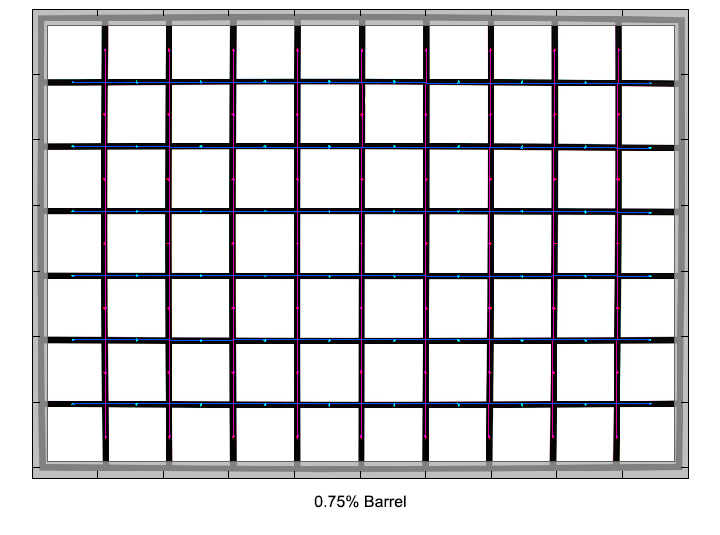|
Page 2 of 3

Distortion
The Tamron SP 35mm f/1.8 Di VC USD produces a slight amount of barrel distortion of ~0.7 % which is pretty good for a moderate wide angle lens.

The chart above has a real-world size of about 120x80cm.
Vignetting
Very fast lenses usually suffer from pronounced vignetting at large apertures, and the Tamron lens is no exception to this rule. Wide open, there is a very visible amount of light fall-off (~1.7 EV) towards the corners. As usual, stopping down reduces the amount of vignetting considerably. From f/4 onward it should no longer be an issue for most scenes.
We're performing our vignetting analysis based on
(uncorrected) JPEGs straight from the camera. The JPG engine of the Nikon D3x features a rather flat
gradation curve, thus has a moderate contrast characteristic, resulting in comparatively low vignetting figures - the
corresponding Canon figures are roughly 40% higher due to the more
aggressive default contrast setting.

MTF (resolution)
The Tamron delivered decent results in the MTF lab. The good news is that the center resolution is great even at the maximum aperture. The border and corner quality is visibly softer here though.
Stopping down to f/4 lifts the borders and corners to very good levels. The peak performance on the D3x is reached at f/5.6 with an outstanding center and a very good quality in the outer image field.
Diffraction is limiting the quality from here with a really noticeable impact from f/11 onward.
The field curvature is low. The centering quality of the tested sample was ok (albeit not great).
It is worth mentioning that the lens showed no visible focus shifting when stopping down (residual spherical aberration).
Please note that the MTF results are not directly comparable across the different systems!
Below is a simplified summary of the formal findings. The chart shows line widths
per picture height (LW/PH) which can be taken as a measure for sharpness.
If you want to know more about the MTF50 figures you may check out the corresponding
Imatest Explanations

Chromatic Aberrations (CAs)
Chromatic aberrations (color shadows at harsh contrast transitions) are well controlled showing moderate readings around 0.6 to 0.7 pixel width at the image borders.

Bokeh
One of the primary usage scenarios for a large aperture lens is to isolate the main subject from the fore- & background via a shallow depth-of-field. The quality of the bokeh (out-of-focus blur) is of major significance for the overall impression of such images.
The Tamron SP 35mm f/1.8 Di VC USD provided mixed results within the scope of a moderate wide-angle lens. The general out-of-focus blur is quite smooth both in the foreground as well as in the more important image background, with some sings of nervousness in the latter.
Unfortunately out-of-focus highlights are pretty bad. As you can see below they suffer from a substantial amount "onion rings". This is usually caused by aspherical elements (the Tamron has 2 of them). There's no outlining effect and the circular disc shape remains intact at smaller apertures, but this doesn't rescue the situation here really.

Bokeh Fringing
Bokeh fringing is a common issue with relatively fast glass. It's visible as halos of different colors in out-of-focus areas - magenta (red + blue) in front of the focus point
and green beyond.
Typical for most fast primes, the Tamron shows noticeable bokeh fringing at large aperture settings, which can of course be reduced by stopping down.
In addition, these shots also illustrate that there is no visible focus shifting when stopping down.
|